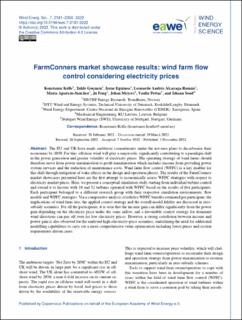| dc.contributor.author | Kölle, Konstanze | |
| dc.contributor.author | Göcmen, Tuhfe | |
| dc.contributor.author | Eguinoa, Irene | |
| dc.contributor.author | Alcayaga Roman, Leonardo Andres | |
| dc.contributor.author | Aparicio-Sanchez, Maria | |
| dc.contributor.author | Feng, Ju | |
| dc.contributor.author | Meyers, Johan | |
| dc.contributor.author | Pettas, Vasilis | |
| dc.contributor.author | Sood, Ishaan | |
| dc.date.accessioned | 2022-11-18T09:38:03Z | |
| dc.date.available | 2022-11-18T09:38:03Z | |
| dc.date.created | 2022-11-03T14:35:52Z | |
| dc.date.issued | 2022 | |
| dc.identifier.citation | Wind Energy Science. 2022, 7 (6), 2181-2200. | en_US |
| dc.identifier.issn | 2366-7443 | |
| dc.identifier.uri | https://hdl.handle.net/11250/3032780 | |
| dc.description.abstract | The EU and UK have made ambitious commitments under the net-zero plans to decarbonise their economies by 2050. For this, offshore wind will play a major role, significantly contributing to a paradigm shift in the power generation and greater volatility of electricity prices. The operating strategy of wind farms should therefore move from power maximisation to profit maximisation which includes income from providing power system services and the reduction of maintenance costs. Wind farm flow control (WFFC) is a key enabler for this shift through mitigation of wake effects in the design and operation phases. The results of the FarmConners market showcases presented here are the first attempt to economically assess WFFC strategies with respect to electricity market prices. Here, we present a conceptual simulation study starting from individual turbine control and extend it to layouts with 10 and 32 turbines operated with WFFC based on the results of five participants. Each participant belonged to a different research group with their respective simulation environments, flow models and WFFC strategies. Via a comparative analysis of relative WFFC benefits estimated per participant, the implications of wind farm size, the applied control strategy and the overall model fidelity are discussed in zero-subsidy scenarios. For all the participants, it is seen that the income gain can differ significantly from the power gain depending on the electricity price under the same inflow, and a favourable control strategy for dominant wind directions can pay off even for low electricity prices. However, a strong correlation between income and power gain is also observed for the analysed high-electricity-price scenarios, underlining the need for additional modelling capabilities to carry out a more comprehensive value optimisation including lower prices and system requirements driven cases. | en_US |
| dc.description.abstract | FarmConners market showcase results: wind farm flow control considering electricity prices | en_US |
| dc.language.iso | eng | en_US |
| dc.publisher | EAWE | en_US |
| dc.rights | Navngivelse 4.0 Internasjonal | * |
| dc.rights.uri | http://creativecommons.org/licenses/by/4.0/deed.no | * |
| dc.title | FarmConners market showcase results: wind farm flow control considering electricity prices | en_US |
| dc.title.alternative | FarmConners market showcase results: wind farm flow control considering electricity prices | en_US |
| dc.type | Peer reviewed | en_US |
| dc.type | Journal article | en_US |
| dc.description.version | publishedVersion | en_US |
| dc.rights.holder | The Authors | en_US |
| dc.source.pagenumber | 2181-2200 | en_US |
| dc.source.volume | 7 | en_US |
| dc.source.journal | Wind Energy Science | en_US |
| dc.source.issue | 6 | en_US |
| dc.identifier.doi | 10.5194/wes-7-2181-2022 | |
| dc.identifier.cristin | 2068711 | |
| dc.relation.project | EC/H2020/857844 | en_US |
| dc.relation.project | Norges forskningsråd: 321954 | en_US |
| cristin.ispublished | true | |
| cristin.fulltext | original | |
| cristin.qualitycode | 1 | |

